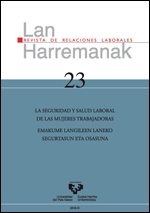Algunos aspectos relativos a la prevención y protección de la maternidad y la lactancia de las trabajadoras autónomas y TRADES
##plugins.themes.bootstrap3.article.main##
##plugins.themes.bootstrap3.article.sidebar##
Abstract
The aim of this work is to analyse some issues regarding health and safety at work and the protection of self-employed female workers or those who are financially dependent against risks during pregnancy and while breastfeeding. In this respect, an attempt is made to make it clear that evolution in terms of prevention governed by the Law governing the Status of Self-Employed Workers' (LETA), while sensitive, has not resulted in legislators imposing any obligations with regard to the establishment of preventive measures against the risks faced by these workers. This continues to be to a large extent subordinate to the principle of self-governing powers with the force of law, which entails huge difficulties when exercising correlative rights of social protection in view of the updating of the aforementioned risks.
How to Cite
##plugins.themes.bootstrap3.article.details##
Authors who publish in the journal "Lan Harremanak" do so in agreement with the following terms:
1. Authors retain the copyright of their papers. while ceding to the journal "Lan Harremanak" the right to the first publication of their article.
2. The publisher UPV/EHU Press is a joint copyright holder, in order to protect the legitimate use of the published paper and compliance with CC terms.
3. Published papers are subject to a Creative Commons CC-BY license (unless stated otherwise) which permits third parties to share the paper, on the condition that the author and source are specified when material is reproduced.
4. Authors can enter into other non-exclusive license agreements regarding the published version of their work (e.g. depositing it in an institutional repository or re-publishing it as a monographic volume), providing the author and source are given appropriate credit.
5. Dissemination of submitted articles via Internet is both allowed and recommended (e.g. in institutional repositories and/or on the researcher's web page), both before and during the process of submission, since this can lead to interesting dialogues and also increase citations to the eventual publication.

